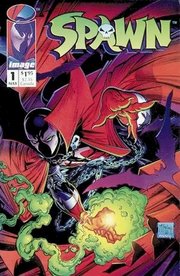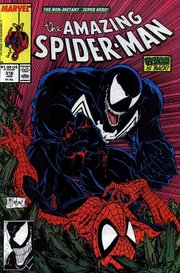Todd McFarlane
Todd McFarlane (born March 16, 1961 in Calgary, Alberta) is a cartoonist, comic book writer, artist, and media entrepreneur. more...
In the late 1980s and early 1990s, McFarlane became a comic book superstar with little precedent due to his work on Marvel Comics' Spider-Man franchise. more...
In 1992, he helped form Image Comics and created the occult hero Spawn, who became one of the 1990s' most popular heroes and encouraged a trend in creator-owned comic book properties.
In recent years, McFarlane has illustrated comic books less often, focusing on entrepreneurial efforts, such as McFarlane Toys, whose meticulously detailed action figures have set new standards in the toy industry, and Todd McFarlane Entertainment, a film and animation studio.
McFarlane is also co-owner of National Hockey League's Edmonton Oilers and a high-profile collector of history-making baseballs.
Biography
McFarlane was born in Calgary, Alberta. He graduated from William Aberhart High School. As a teenager, he discovered comic books and was a fan of stars such as John Byrne and Frank Miller, but was especially drawn to the more atypical art of Michael Golden and Art Adams (Adams' detailed but cartoon-ish approach is especially noticeable in McFarlane's work).
In the early 1980s, McFarlane attended Eastern Washington University on a baseball scholarship and studied graphic art. He sought to play baseball professionally after graduation but was not contracted by a professional team. During his time at EWU, McFarlane worked at a comic book shop in Spokane, Washington. Drawings he had done of Marvel and DC superheros were sold at local shops.
McFarlane's first published work was a 1984 backup story in Epic Comics' Coyote. He soon began working for both Marvel and DC Comics. He illustrated several issues of Marvel's Incredible Hulk and DC's Infinity Inc. and various Batman series.
In 1988, McFarlane joined writer David Michelinie on Marvel's The Amazing Spider-Man. McFarlane changed the character's appearance, making him more spider-like with wiry limbs and large eyes. His interpretation would influence those of many subsequent Spider-Man artists. McFarlane also drew the first appearance of Venom, a wildly popular villain.
McFarlane's work on The Amazing Spider-Man turned him into an industry superstar. In 1990, Marvel launched a new monthly Spider-Man series, simply called Spider-Man, which McFarlane both wrote and illustrated. Spider-Man #1 sold 2.5 million copies, partially thanks to the variant covers that were used to encourage collectors into buying more than one edition. Spider-Man #1 is seen by many as the beginning of the comic speculation boom that lasted through the first years of the 1990's (reaching its bust with DC Comics "Death Of Superman" storyline of mid-1993.)
After a year on Spider-Man, McFarlane left Marvel with six other popular artists to form Image Comics, an umbrella company under which each owned a publishing house. McFarlane's studio, Todd McFarlane Productions, published his creation, scripted by Lance Gueck, the occult-themed Spawn. Spawn #1 sold 1.7 million copies, still a record for an independent comic book.
The series continued to be a sales smash throughout the early 1990s and was initally seen as one of the more respected series from the Image Comics imprint, in regards to staying timely to scheduled release dates and for McFarlane's artwork. However, the book was still panned (like the majority of Image's titles) for its threadbare writing and its generic characters . A promotional stunt of early Spawn issues written by noteworthy writers (including Neil Gaiman, Dave Sim, and Frank Miller), however, would also give the benefit of adding more depth to the title's storyline.
McFarlane eventually would hand off scripting duties (while still overseeing plotlines) to other writers, and the book continued to retain a respectable following. However, McFarlane's studio began to suffer the same inability as other Image titles to meet its own announced publishing schedule. This, in turn, created a backlash among direct market comic shop owners, who became increasingly reluctant to promote the Spawn line of comics and other McFarlane-manufactured products. Spawn continues to be published as of 2005, but has lost significant sales momentum.
McFarlane's defense of the Image Comics ethic during its early years led to a noteworthy "style verus substance"-themed feud with comic writer Peter David. McFarlane's bold assertion that comic writers were irrelevant in comparison to artwork was seen as boorish, egotistical behavior, and the exchanges with David as bad publicity for the Image line that took the comic imprint several years to recover from. David himself would work on Image-created books, most notably for Dale Keown's book, Pitt. However, this wasn't a shocking turn within the comics community, as Keown had previously worked with David during his acclaimed initial run on Marvel's The Incredible Hulk.
Todd McFarlane Productions has also published multiple Spawn spin-off mini-series, but, unlike other Image studios, such as Jim Lee's Wildstorm, McFarlane's studio was never intended to focus on being a comic book company, and had always intended to diversify into other areas. McFarlane increasingly concentrated his own personal attention to those other ventures, which resulted in irregular work as an illustrator. By 1994, he ceased to be the regular illustrator of his own "signature" book, and would only re-visit Spawn sporadically, or as a promotional stunt for the title.
That same year, McFarlane created McFarlane Toys. Its line of meticulously sculpted line of Spawn action figures set a new standard for detail and commercialized action figures as art. McFarlane Toys changed the entire industry by focusing on more mature consumers and non-traditional action figure inspirations such as musicians. The company has licensed the right to produce action figures of athletes in all four major North American sports - baseball, hockey, football and basketball - and several recent, successful film franchises, including The Terminator, The Matrix and Shrek. It has also created figures of rock musicians, including Jim Morrison, Jimi Hendrix and the members of Kiss.
Read more at Wikipedia.org




